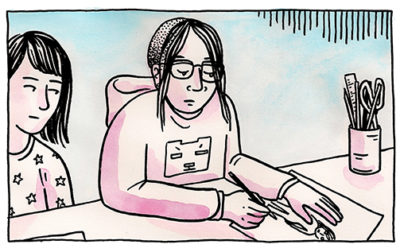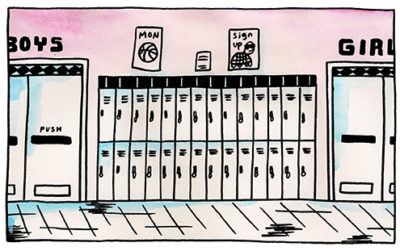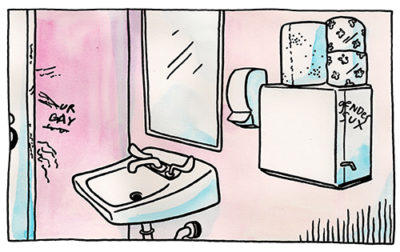On the first day of school this year, I asked my students – 6th graders – to write down their personal preferred pronouns on an index card, along with other info about themselves. I demonstrated writing mine (she/her) on the document camera, and gave other pronoun examples: he/him, they/theirs.

I got a few blank stares, and a few clarifying questions. Mostly I saw expressions that belied the feeling, “Uh, why are you asking me this?” (Or so I assume.)
I was posing this question to them because asking about others’ preferred pronouns has become common practice in more and more of the other spheres of my life. Why wouldn’t I introduce this practice in an art room, where I want to foster trust, and create a safe space for sharing essential aspects of ourselves?
As a cisgender woman (I identify as the same gender that I was assigned at birth), sometimes telling my pronouns feels tedious (“Nothing surprising here…”). But I agree with the idea that our society is a safer, better place for everyone when we all define and redefine our gender expression throughout our lives.
My students are young – eleven years old, mostly. They are growing up in a world that has categories for gender expression that certainly weren’t available to me in my small town in the 90’s, when I was in 6th grade. Language is continually evolving and shifting as our collective understanding of gender shifts: labels like “gender-non-conforming,” “non-binary,” even “transgender,” are relatively new. The term “intersex” might not be new, but understanding of it as an identity is changing.
When I read students’ index cards later, I was touched by the fact that they simply did it – they wrote down their preferred pronouns, even if it felt like a “No duh,” and maybe that act, alone, got them thinking about gender in new ways. I regretted not having them share their pronouns with others in their table groups – that’s at least as important as telling me. I made a note to myself to do that part differently on the first day of school next year.

A few weeks later, we were watching a short video interview with the artist Louie Gong – he talks about his identities. This idea, that we all have many identities, was new to many of them. I used some examples, “Maybe you identify as a young person, as a Muslim, as a boy, as a skateboarder, as an East African.” The concept that identities are overlapping, and not necessarily fixed, connects to their understanding of their gender. You might be “he/him” today, and “they/them” next September.
I haven’t yet seen examples of students explicitly exploring their gender identities in their artwork, but then again: when was the last time I made artwork directly about my own identity as “female”? Maybe it’s creeping in, in their sketchbooks, or in questions I hear about whether the people in their drawings look “like a girl” or “like a boy”?
The Office of Superintendent of Public Instruction outlines the rights of WA state students around Gender Identity and Expression. “Students have the right to express their gender at school – within the constraints of the school’s dress code – without discrimination or harassment.” But how do we prevent discrimination and harassment?
Students also have a right to use restrooms and locker rooms “consistent with their gender identity.” A federal decision in 2016 requires all states to commit to these policies to protect transgender youth, or risk losing federal funding.
My school has a single gender-neutral, single-occupancy bathroom available to students – it’s near the main office, and I used it one day last week. I noticed some discreet graffiti along the doorframe inside. “Hey queers.” “If you’re cis and straight, don’t use this bathroom.” I moved in to look closely and saw more. “I want to die” was followed by a suicide hotline number in different handwriting.

How do we develop students’ empathy and understanding for others’ gender expression, and for their own? A gender-neutral bathroom is a great start, institutionally, for protecting the needs of transgender students. I’m also heartened by the ways that queer students are showing up for each other – through sharpie messages on the walls, and otherwise. But we need classrooms, and hallways, and locker rooms that are safer and more welcoming of all of our unique gender expressions and bodies.
I’m looking for more ways to expand students’ understanding of their own gender identities, and I hope that creates more appreciation for others’ evolving selves.
YES! I love that you wrote this piece. I did something similar with my students at the start of the year and I was surprised how a small gesture made a difference for the students that don’t identify in the binary. It was also great for students who’ve never thought about this before!
This is lovely & thoughtful. Thank you!
I have some students (high school) who identify as non-binary and have requested “they/them” or request pronouns which, superficially based on outward appearances, seem like the “wrong” pronoun.
What is sad to me is that I see teachers turn this into a power struggle or a political statement. Seriously, if a kid is more comfortable with me using “they,” and by my doing so I prevent them from feeling excluded, I can think of no valid reason to not honor that request.